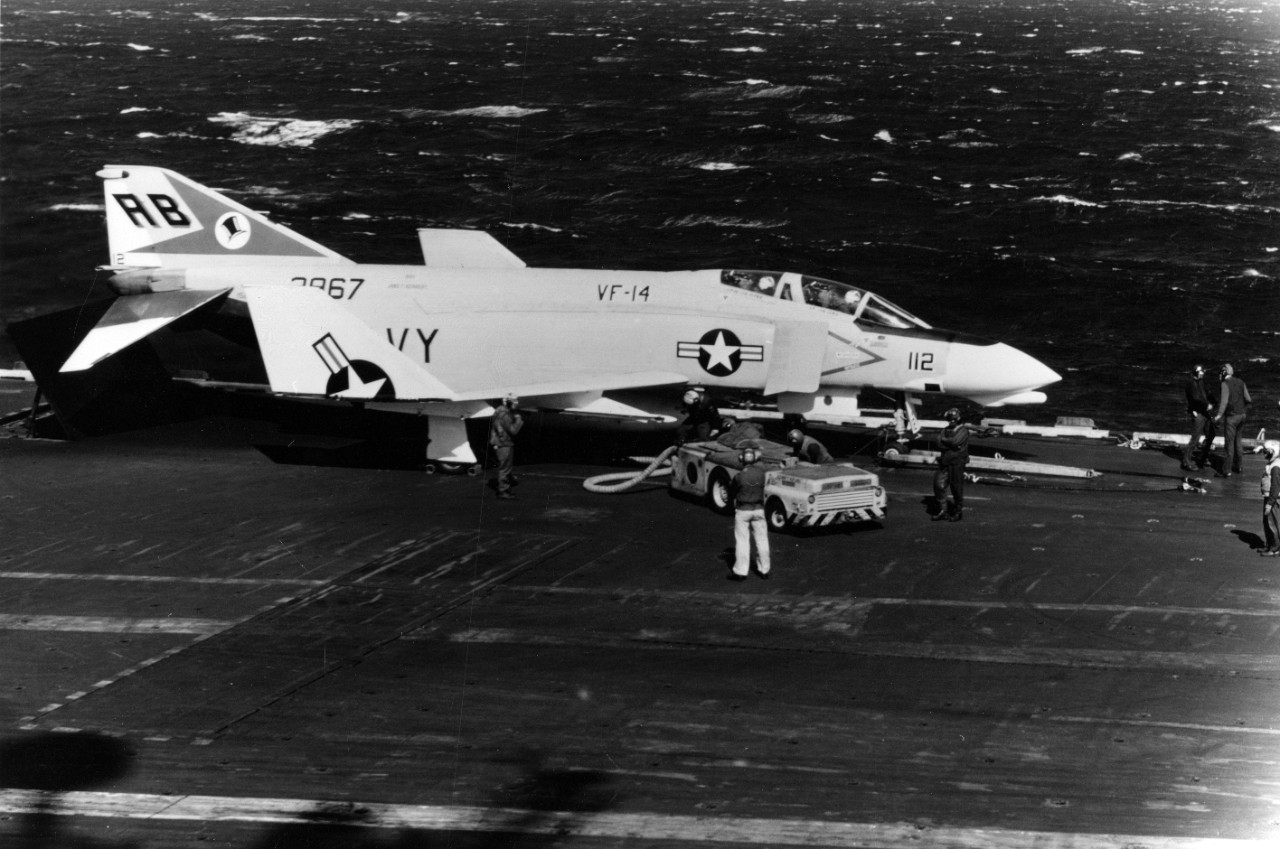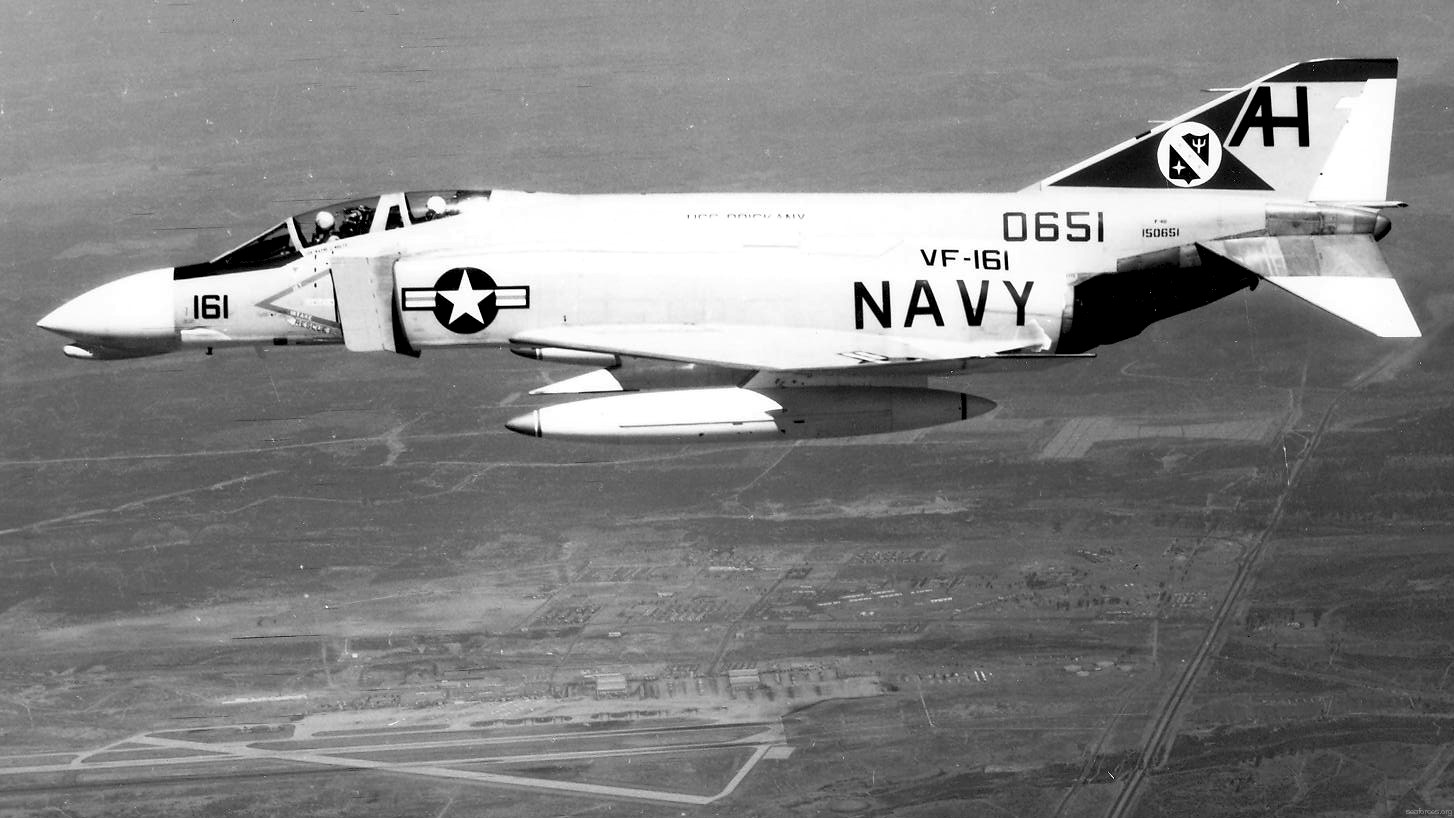F-4 Phantom Navy - After testing and evaluating the Navy's loaner F-4Bs, the first production F-4C was delivered to the United States Air Force in November 1963. The 4453rd Aircrew Training Fighter Wing at MacDill AFB was the first unit to receive the Phantoms. The first combat unit to receive the F-4C was the 12th Tactical Fighter Wing in 1964.
RF-4C with additional fuel tanks in flight in August 1968.
F-4 Phantom Navy

179th Tactical Reconnaissance Squadron, 179th Interceptor; 148th Tactical Reconnaissance Group, 148th Fighter Interceptor Group (RF-4C and F-4D)
Ne000142 F 4j Phantom Ii 157307
The Phantom entered service with the United States Navy on 30 December 1960 with pacemakers VF-121 at NAS Miramar. VF-74 Be-Devilers at NAS Oceana became the first deployable Phantom squadron, receiving their F4H-1s (F-4Bs) on 8 July 1961.
These types of units are known in naval parlance as Replacemt Air Groups (RAG) or Fleet Replacemt Squadrons (FRS). The purpose of these specific training units was to provide fleet squadrons with aircrew and maintenance personnel qualified for the F-4 Phantom. During the Vietnam War, they also provided spare aircraft to replace those lost.
VF-101's DACT detachment was located at NAS Key West, Florida and flew the A-4 Skyhawk and F-4 Phantom II.
VF-171's DACT detachment was located at NAS Key West, Florida, flying the A-4 Skyhawk and F-4 Phantom II. VF-171 assumed the role of training the Atlantic Fleet F-4 Fleet Replacemt Squadron after the transition from VF-101 to the Fleet Replacemt Squadron for the F-14 Tomcat.
E Flite F 4 Phantom Ii 80mm Edf Pnp
These units provided services to the fleet such as air combat training and enemy electronic warfare simulation support.
The US Marines received their first F-4Bs in June 1962, with VMFA-314 Black Knights at MCAS El Toro, California, becoming the first operational squadron. In addition to the attack variants, the Marines also operated several tactical reconnaissance RF-4Bs. The Marine Phantoms of VMFA-531 Gray Ghosts arrived in Vietnam on 10 April 1965, conducting close air support missions from land bases and the USS America. Marine F-4 pilots took out three enemy MiGs (two while on rotational duty with the USAF) at a cost of 75 aircraft lost in combat, mostly to ground fire and four in accidents. On January 18, 1992, the last Marine Phantom, an F-4S, was retired from VMFA-112 Cowboys.
NOTE: USMC squadrons transfer their tail codes to the appropriate Carrier Air Wing (CVW) tail when operating on aircraft carriers as part of an integrated USN/USMC CVW.

These types of units are known in the Navy and Marine Corps as Replacemt Air Groups (RAG) or Fleet Replacemt Squadrons (FRS). The purpose of these specific training units was to provide Fleet Marine Force (FMF) squadrons with aircrew and maintenance personnel qualified for the F-4 Phantom. During the Vietnam War, they also provided spare aircraft to replace those lost. The remarkable career of the McDonnell Douglas F-4 Phantom II began exactly 60 years ago when the first example was delivered to the US Navy to train pilots of the "curved-wing wonder". That delivery began a monumental run for the classic Cold War fighter, owned by three US services and a host of foreign operators. It wasn't until 2016 that the curtain came down on Phantom's US military service, an event that
File:f 4 Phantom Ii Vf 21.jpg
It was Fighter Squadron 121 (VF-121), the Pacemakers, that had the honor of putting the first Phantoms into service anywhere in the world. On 30 December 1960, VF-121 took command of its first F4H, as the Phantom was then known, a fighter supplied by McDonnell Aircraft Corporation of St. Louis, Missouri, at the squadron's home base at Naval Air Station Miramar, California. It was not until September 1962 that the Phantom received its more familiar F-4 designation under the triple nomenclature system.
The VF-121 Pacemakers eventually replaced their early production Phantoms with the much improved F-4J model, one of which returned to Miramar in 1978. US Navy
These first Phantoms for VF-121 were the F4H-1F model, known as the F-4A since 1962, of which only 45 were produced. That's a relative drop in the ocean compared to the 5,195 F-4s that were eventually produced, not only in the United States, but also in Japan, where the type had just been withdrawn from the front line. Meanwhile, troops in Greece, Iran, Turkey and South Korea continue to push.
As the first recipient of the large new all-weather fighter, the WF-121 Pacemakers role was tasked with training pilots and Radar Intercept Officers (RIOs) for the Phantom as a West Coast fleet replacement air group (RAG) . or school house for the guy. After the Phantom added the RIO, the training effort increased commensurately—the second crew member hadn't been in a US Navy combat cockpit since the subsonic F3D Skyknight about a decade earlier. The RIO's task was to operate the Phantom's Westinghouse advanced radar, a piece of space-age avionics that also featured a Raytheon missile fire control system, an advanced navigation suite, and an analog air data computer.
Patriots Point's F 4j Phantom
The idea of the caliber of the newfound Phantom Flyers coming out of VF-121 was given by Commander Charles "Pete" Conrad and Lt. Col. Richard F. "Dick" Gordon, who both went from training with Pacemakers to participating in the Apollo 12 lunar mission.
Another McDonnell product, the F3H Demon, was still being flown by VF-121 "Pacemakers" when the first Phantoms began to arrive., the US Navy
On the East Coast, the equivalent RAG was VF-101, "Grim Reaper," at Naval Air Station Oceana, Virginia, one detachment of which actually split off and moved to Miramar to become VF-121 earlier.
Apart from the two crew members, the Phantom was already a vast improvement over the F3H Demon and F11F Tiger that the Pacemakers had piloted so far. It was significantly larger and more powerful - with two engines instead of one. Despite the lack of the planned J79-GE-8 turbojets, even the interim GE-2 series engines in the F4H-1F delivered more than 16,000 pounds of afterburner thrust each, allowing them to reach speeds in excess of Mach 2.
The Navy Got Its Hands On Its First Operational F 4 Phantom Sixty Years Ago Today
As for armament, the Phantom was designed without a cannon, instead relying on guided missiles, an oversight to be remedied after the jet was thrown into the close combat of the Vietnam War. During the same conflict, the F-4 emerged as a true multirole platform, perhaps the first of its kind, carrying a larger arsenal of more varied weapons than any of its contemporaries.
However, the early days of phantom flying were dangerous. The first F4H-1 prototype crashed at Edwards Air Force Base, California, in October 1959, during a work flight for a world speed record attempt, claiming the life of test pilot Gerald "Zack" Huelsbeck.
Bureau F4H-1 Phantom II 142259 was the aircraft lost in the October 1959 crash that killed test pilot Gerald "Zack" Huelsbeck., San Diego Air and Space Museum
Then, in May 1961, Commander J.L. Felsman was killed during a low-level speed run in an early production F4H-1. This crash and another in the Patuxent River, Maryland, bore the hallmarks of pilot-induced oscillation, or PIO, when the pilot's excessive input to the flight controls caused the plane to vibrate, effectively pulling apart.
Watch: Every F 4 Phantom Ii From The First To The Last Was Phabulous
One of the first in VF-121 to receive the new Navy Phantom was Commander Wilbur Norton, who pondered the aircraft's spawning problems:
The Phantom itself was incredibly stable. Indeed, the stability of the design was a marked improvement over what we were flying then. But those who were fisted would control the Phantom too much or correct him too much if something went wrong. The plane would then start oscillating like crazy. The best way to get away from this high vibration problem is to take your hands off the controls and just watch. At high altitude you can recover easily. At low altitude, the PIO is instantly dead.
Ultimately, PIO did not reflect an inherent flaw in the Phantom's basic design, but was more about pilots learning to adapt to the complexities of this extraordinarily powerful machine. The RAGs training curriculum was adapted accordingly, emphasizing a light touch on the controls, even when tossing the jet around in simulated combat.

A camouflaged F-4G of VF-121 at Miramar in 1966. Only 12 of this model Phantom were converted from the F-4B, with a data link system and other changes., US Navy
F 4js Advanced
Early experiences with the Phantom show that even purebred creation is not without problems, with airframes and lives lost in high-profile accidents. However, in February 1962, the F4H-1 was ready to go operational for the first time, when VF-102 embarked USS Enterprise (CVAN-65). The world's most advanced aircraft carrier - then on its shakedown cruise - made a fitting place for the Phantom, which would soon establish itself as a pre-eminent naval fighter before embarking on an equally successful career on land. McDonnell F-4N Phantom II (BuNo 151491) by Fighter
F 4 phantom patches, f 4 phantom shirt, f 4 phantom, f 4 phantom jet, f 4 phantom pictures, us navy f 4 phantom, f 4 phantom aircraft, f-4 phantom navy, f 4 phantom books, raf f 4 phantom, navy f 4 phantom pictures, f 4 phantom parts
0 Comments